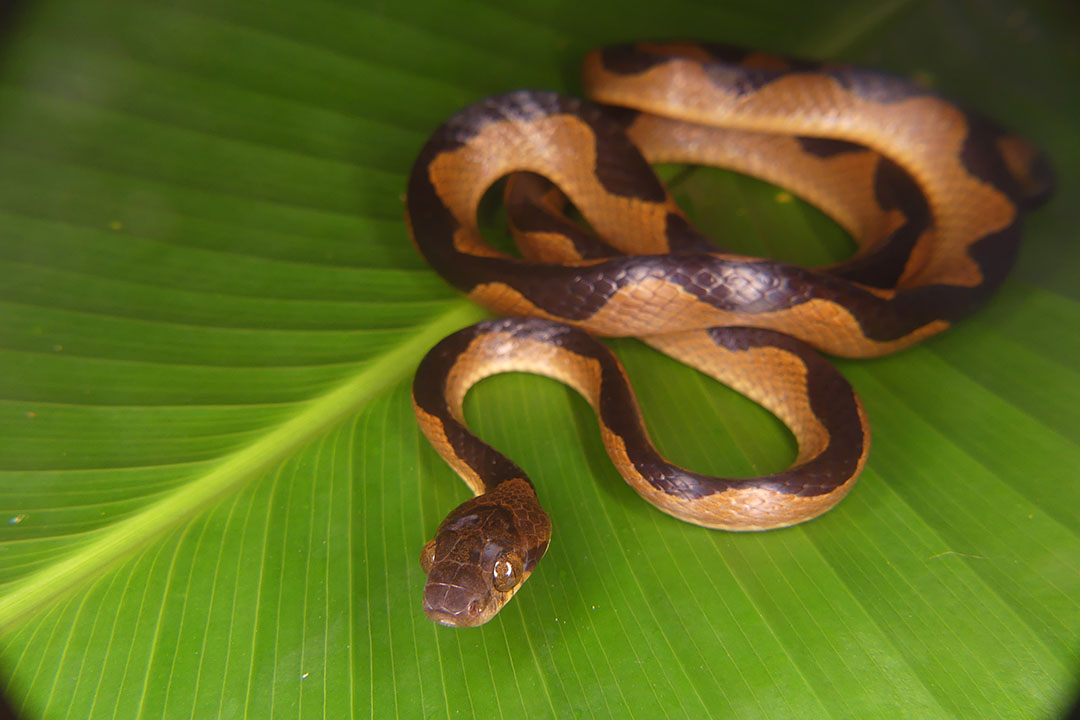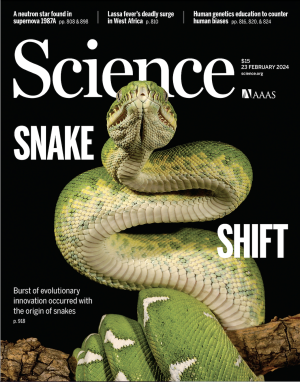More than 100 million years ago, the ancestors of the first snakes were small lizards that lived alongside other small, nondescript lizards in the shadow of the dinosaurs.
Then, everything changed. In a burst of innovation in form and function, snakes experienced one of the most dramatic evolutionary shifts of all time. They rapidly developed elongated legless bodies that could slither across the ground, climb into trees, burrow under the earth and crawl along the seabed. They acquired flexible skulls that enabled them to swallow large animals. Their habitats expanded. Their diets grew.
This evolutionary explosion—a rapid transformation of species characteristics and traits known as adaptive radiation—ushered in the next 66 million years of snake diversification.
Now, a research team featuring George Washington University Associate Professor of Biology Alexander Pyron has completed a decade-long, multi-grant supported project that constructed the most comprehensive evolutionary tree of snakes and lizards ever. In a study published in the journal “Science,” the researchers present a vivid picture of how snakes pulled off what they describe as a once-in-evolutionary-history event.
“There are thousands and thousands of species of snakes that evolved very quickly across every possible range of habitats, niches and diets,” said Pyron, a co-author of the study. “We’ve got snakes in the trees, in the ocean, in freshwater, underground, on land—in all these different areas! That’s something very few—if any—other groups have achieved.”
The findings draw from large new genetic and dietary studies of snakes conducted by biologists from universities and museums in the United States, the United Kingdom, Australia, Brazil and Finland. The study’s 20 authors revealed that snakes evolved up to three times faster than lizards, with massive shifts in traits associated with feeding, locomotion and sensory processing.
“Snakes evolved faster and—dare we say it—better than some other groups,” said University of Michigan evolutionary biologist Daniel Rabosky, senior author of the study. “They are versatile and flexible and able to specialize on prey that other groups cannot use.”
In addition to speed, Pyron said that snakes had a remarkable variety of evolutionary shifts. “Not only did [snakes] evolve very quickly, but in many different directions at once,” he noted. Almost simultaneously, snakes lost their legs and became longer and thinner, allowing them to slither and burrow into new habitats. Their jaws and skulls evolved to enable them to swallow prey 10 times as large as their heads.
Indeed, Pyron, who has studied snakes for more than 20 years, said that evolutionary diversity was perhaps the most surprising aspect of the team’s research. “We thought maybe they’d show something exceptional in one area but maybe not in another,” he said. “But, no, it’s every single thing—increased rates of body form evolution, increased rates of diet evolution, increased rates of niche evolution. Snakes stand out as a huge cut above every other group of lizards.”
The study was supported by several funding agencies, including multiple grants from the National Science Foundation.
Rattling the evolutionary tree
For the study, researchers including Pyron generated the largest, most comprehensive evolutionary tree of snakes and lizards ever from genome scale data on more than 1,000 species along with partial DNA data sets from about 80 percent of all lizard and snake species.
In addition, they compiled a massive data set on lizard and snake diets, examining records of stomach contents from tens of thousands of preserved museum specimens.
They fed the data cache into sophisticated mathematical and statistical models to analyze the history of snake and lizard evolution through geological time and to study how various traits, such as limblessness, evolved.
“We put together not only the most comprehensive molecular data set of DNA from genomics to understand evolutionary history, but also the most comprehensive data set that’s ever been put together for the actual natural history of the species,” Pyron said. “Combining these, we can conduct an evolutionary analysis of [snakes’] natural history and pinpoint where we see these dramatic changes: Where do they live? What do they look like? What are their measurements? What are they eating?”
The ultimate causes, or triggers, of the adaptive radiations remains a mystery. While it’s likely there were multiple contributing factors, the study’s authors referred to the phenomenon as a macroevolutionary singularity—a sudden shift into a higher evolutionary gear—with “unknown and perhaps unknowable” causes.
Still, Pyron said the study broadens our understanding of the unique nature of snakes. “Snakes are different. Everybody intrinsically recognizes that, but it had never really been demonstrated what and how and why they were different,” he said. “Now we have a full-scale evolutionary analysis of all their dimensions, their ecology and their evolutionary history.”
Portions of this article were adapted from a University of Michigan press release.




